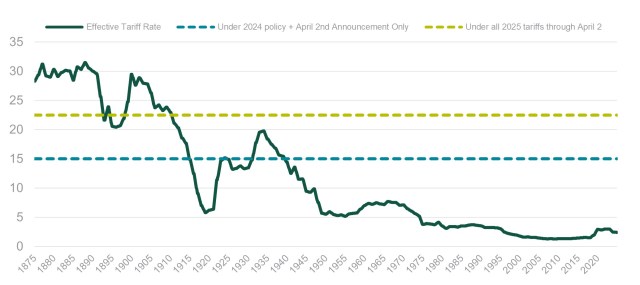Tariffs and Returns: Lessons from 150 Years of Market History
Trade tariffs are back — reshaping markets and raising critical questions for investors. In early 2025, the United States enacted broad-based tariffs on nearly all trading partners, reversing decades of liberalization. The result: renewed volatility, geopolitical tension, and a clear imperative for portfolio resilience. While today’s headlines feel new, the dynamics aren’t. Over the past 150 years, the United States has seen multiple high-tariff regimes — from the post–Civil War boom to the Smoot-Hawley fallout. The global economy has changed, but investor behavior and risk pricing remain governed by familiar patterns. In this blog, we examine those lessons through a data-driven lens, leveraging our proprietary database of 150 years of asset and economic data—the most comprehensive long-term dataset on tariffs, economic growth, and investment returns available to date ([3], [4], [5]). Our objective is not to suggest that history will repeat itself, but to uncover patterns that rhyme — providing context for investors seeking to navigate today’s uncertainty. The evidence shows that while tariffs can introduce stress into markets, systematic equity factors, particularly low-volatility, have historically provided stability and added value during periods of trade disruption. For investors facing a resurgence in protectionist policy, these lessons are both timely and actionable. The History of Tariffs Exhibits 1 and 2 trace the United States through multiple tariff regimes since 1875. From protectionism to liberalization and back again, tariff policy has reflected broader political and economic forces. This long-run view offers important context for today’s shifts. Exhibit 1: US Effective Tariff Rate Since 1875 Yale BudgetLab and Northern Trust Asset Management – Quantitative Strategies. The effective US tariff rate is measured as customs duty revenue as a percent of goods imports. The sample period is 1875-2024. Exhibit 2: Historic Tariff Trends Yale BudgetLab and Northern Trust Asset Management – Quantitative Strategies. 1875-1913: Protectionist Peak In the Civil War the United States implemented the Morrill Tariff in 1861, raising average tariff rates on dutiable commodities to approximately 47% to generate revenue for the Civil War. From the post-Civil War era (which was 1861–1865) to World War I, tariffs remained high to protect flourishing industries. Tariffs on dutiable imports averaged between 30% and 50%, reflecting the Republican Party’s commitment to industrial development through trade barriers, amounting to effective tariffs of around 30%. Notable legislation includes the Morrill Tariff (1861), the McKinley Tariff (1890), and the Dingley Tariff (1897), the latter of which marked the height of protectionism in this era. 1913–1920s: First Liberalization The Underwood Tariff Act of 1913, enacted under President Woodrow Wilson, marked a turning point by reducing the basic tariff rates. In addition, many raw materials and groceries were added to the free of tariff list. This shift was driven by Democratic efforts to promote freer trade and encourage American manufacturers to produce more efficient and become more competitive with their prices, lowering the average cost for consumers. 1930s: Smoot-Hawley Era The 1929 stock market crash triggered a global downturn, prompting countries to protect domestic industries. In 1930, the United States passed the Smoot-Hawley Tariff Act, raising duties on over 20,000 imports—pushing average tariff rates to 45%. Instead of stabilizing the economy, the policy sparked global retaliation, with major trading partners like Canada, the United Kingdom, and Germany imposing countermeasures. The result: a trade war and a 60% drop in world trade by 1933. Post-WWII to 1970s: Trade Liberalization Era After World War II, U.S. policy pivoted toward multilateral liberalization through the General Agreement on Tariffs and Trade (GATT). Through negotiation rounds, resulting in over 100 agreements, including Geneva, Dillon, Kennedy, and Tokyo, average tariffs on industrial goods fell dramatically. By the 1970s, US tariffs were around 10% or lower, reflecting a global trend toward freer trade. 1990S–2000s: NAFTA and WTO Integration With the signing of NAFTA (1992) coming into force (1994) and the U.S. joining the WTO (1995), tariff barriers declined even further. By the 2010s, average tariffs on all US imports had dropped to approximately 1.5–2.5%, reflecting the peak of US trade openness. 2018–2020s: Strategic Protectionism Beginning in 2018, the Trump administration imposed a 10% blanket tariff on imports, along with additional levies targeting countries with large trade surpluses with the United States, notably China. These measures marked a shift toward selective protectionism and initiated retaliatory tariffs by major trading partners. 2025: Escalation of Broad Tariff Policy In 2025, the United States enacted its most significant trade shift in a century: a 10% blanket tariff on all imports, plus an added levy based on each country’s bilateral goods deficit. Though a 90-day grace period softened the rollout, ongoing exemptions and reversals have created persistent policy uncertainty. The impact has been most acute for China, the primary target, with retaliatory tariffs from Beijing following quickly. The volatile and politically charged environment has complicated forecasting and increased caution among global investors. The threat now hanging over the global economy is that President Trump is orchestrating a return to the 1930s, when the infamous Smoot-Hawley tariffs set off a chain reaction of international retaliation, often blamed for deepening the Depression. This move contrasts sharply with the multilateral liberalization trend of the previous decades. These regimes of US trade tariffs also impact average global tariffs across the world, as other countries either had high tariffs (like European countries in the 19th century) or retaliated (for example during the Smoot-Hawley era). The figure below, taken from Bas, 2012 reveals the average level of global tariffs [2]. Exhibit 3: Unweighted World Average Own Tariff, 35 Countries, % Bas, M. (2012). Input-trade liberalization and firm export decisions: Evidence from Argentina. Journal of Development Economics, 97(2), 81-493. Tariffs are widely regarded as impediments to trade openness. By increasing the cost of cross-border transactions, high tariffs tend to restrict the flow of goods and services, thereby lowering a country’s trade-to-GDP ratio—a standard measure of openness [2]. Exhibit 3 illustrates the historical evolution of US trade openness, defined as the sum of imports and exports as a percentage of GDP, with key tariff regimes highlighted. Exhibit 4: Historical
Tariffs and Returns: Lessons from 150 Years of Market History Read More »













